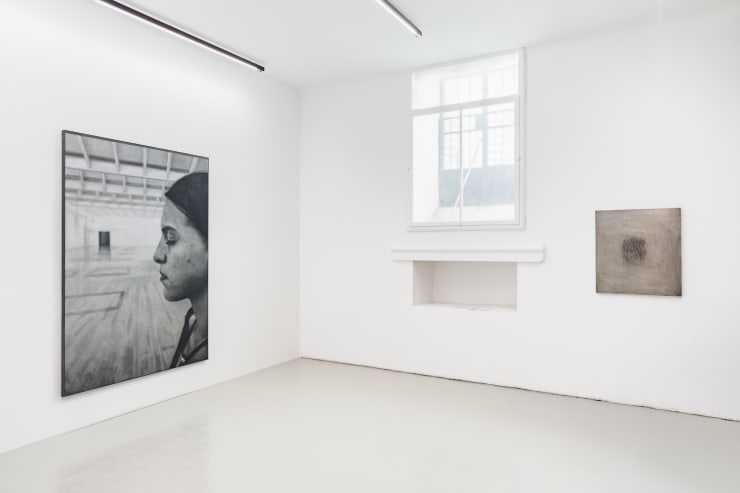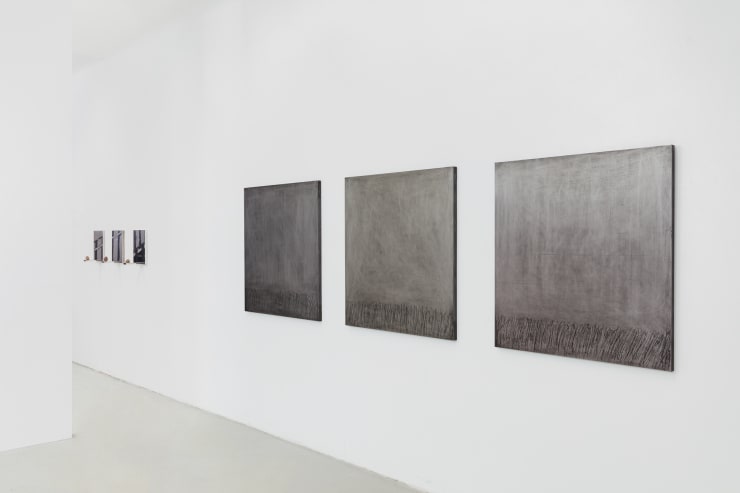Paco Koenig I Do you dream in colour? : Focus on
Paco Koenig (b.1990) lives and works in Berlin. Koenig received his MA in Architecture from the University of Arts, Berlin.
Originally trained as an architect, Paco Koenig's path flowed through architecture and furniture design before resting on painting. Koenig states that his move to painting was triggered by finding a sketch that he had created and felt the impulse to convert into a larger scale work. Finding greater creative control in the medium where he could explore the aspects of architecture and design that interested him in a more autonomous manner.
Koenig's practice involves scraping marks on aluminum surfaces which are then treated with oil colour. Within this practice there are signicant elements of contradiction. For instance, once the mark on the aluminum is made it is impossible to erase which invariably suggest a very conscious and considered technique. However, at the same time the marks are only revealed upon the application of the oil, revealing the forms that lie beneath, creating a consciously unconscious process.
The process of mark making is something that particularly interests Koenig, "I'm just fascinated by the fact that humans have that inner instinct to make a mark on a surface, to be remembered in a way. I think this desire goes back to the cave paintings in the south of France. Those first marks are like a template for everything that comes after, including the screens that we are staring into", Koenig states.
-
![Paco Koenig Wall Piece [Sycophant], 2021 Aluminium and stone 36 x 28 x 18 cm 14 1/8 x 11 1/8 x 7 1/8 in](data:image/gif;base64,R0lGODlhAQABAIAAAAAAAP///yH5BAEAAAAALAAAAAABAAEAAAIBRAA7) Paco KoenigWall Piece [Sycophant], 2021Aluminium and stone36 x 28 x 18 cm
Paco KoenigWall Piece [Sycophant], 2021Aluminium and stone36 x 28 x 18 cm
14 1/8 x 11 1/8 x 7 1/8 in -
![Paco Koenig Wall Piece [Parallax], 2021 Aluminium and stone 36 x 28 x 18 cm 14 1/8 x 11 1/8 x 7 1/8 in](data:image/gif;base64,R0lGODlhAQABAIAAAAAAAP///yH5BAEAAAAALAAAAAABAAEAAAIBRAA7) Paco KoenigWall Piece [Parallax], 2021Aluminium and stone36 x 28 x 18 cm
Paco KoenigWall Piece [Parallax], 2021Aluminium and stone36 x 28 x 18 cm
14 1/8 x 11 1/8 x 7 1/8 in -
![Paco Koenig Wall Piece [The End], 2021 Aluminium and stone 36 x 28 x 18 cm 14 1/8 x 11 1/8 x 7 1/8 in](data:image/gif;base64,R0lGODlhAQABAIAAAAAAAP///yH5BAEAAAAALAAAAAABAAEAAAIBRAA7) Paco KoenigWall Piece [The End], 2021Aluminium and stone36 x 28 x 18 cm
Paco KoenigWall Piece [The End], 2021Aluminium and stone36 x 28 x 18 cm
14 1/8 x 11 1/8 x 7 1/8 in -
![Paco Koenig Untitled [22], 2021 Oil on aluminium 82 x 72 cm 32 1/4 x 28 3/8 in](data:image/gif;base64,R0lGODlhAQABAIAAAAAAAP///yH5BAEAAAAALAAAAAABAAEAAAIBRAA7) Paco KoenigUntitled [22], 2021Oil on aluminium82 x 72 cm
Paco KoenigUntitled [22], 2021Oil on aluminium82 x 72 cm
32 1/4 x 28 3/8 in -
![Paco Koenig 211420920125416114209127 [I], 2021 Oil on aluminium 103 x 98 cm 40 1/2 x 38 5/8 in](data:image/gif;base64,R0lGODlhAQABAIAAAAAAAP///yH5BAEAAAAALAAAAAABAAEAAAIBRAA7) Paco Koenig211420920125416114209127 [I], 2021Oil on aluminium103 x 98 cm
Paco Koenig211420920125416114209127 [I], 2021Oil on aluminium103 x 98 cm
40 1/2 x 38 5/8 in -
![Paco Koenig 211420920125416114209127 [II]],, 2021 Oil on aluminium 103 x 98 cm 40 1/2 x 38 5/8 in](data:image/gif;base64,R0lGODlhAQABAIAAAAAAAP///yH5BAEAAAAALAAAAAABAAEAAAIBRAA7) Paco Koenig211420920125416114209127 [II]],, 2021Oil on aluminium103 x 98 cm
Paco Koenig211420920125416114209127 [II]],, 2021Oil on aluminium103 x 98 cm
40 1/2 x 38 5/8 in -
![Paco Koenig 211420920125416114209127 [III], 2021 Oil on aluminium 103 x 98 cm 40 1/2 x 38 5/8 in](data:image/gif;base64,R0lGODlhAQABAIAAAAAAAP///yH5BAEAAAAALAAAAAABAAEAAAIBRAA7) Paco Koenig211420920125416114209127 [III], 2021Oil on aluminium103 x 98 cm
Paco Koenig211420920125416114209127 [III], 2021Oil on aluminium103 x 98 cm
40 1/2 x 38 5/8 in -
 Paco KoenigBeacon (Ivy Lee), 2021Oil on linen220 x 150 cm
Paco KoenigBeacon (Ivy Lee), 2021Oil on linen220 x 150 cm
86 5/8 x 59 1/8 in
Paco Koenig (b.1990) lives and works in Berlin. Koenig received his MA in Architecture from the University of Arts, Berlin. Originally trained as an architect, Paco Koenig's artistic path flowed through architecture and furniture design before resting on painting. Koenig states that his move to painting was triggered by finding a sketch that he had created and felt the impulse to convert into a larger scale work. Finding greater creative control in the medium where he could explore the aspects of architecture and design that interested him in a more autonomous manner.
Beacon (Ivy Lee) marks the first time Koenig has worked within figurative painting. The work was painted based on a photograph the artist took in 2015. ’I wanted to find out if I can paint this photo that I took years ago. The photo depicts a scene from a specific day, that I remember very clearly. It was a significant moment for me. What was really important to me, was that I don't just paint any picture or photo, but a photograph that I took, that I’m the author of. Also I really liked the composition of the photo. I figured that the winter months spend in lockdown was the perfect time to do this, as the process of painting felt similar to meditation to me.’
The abstract works show a continued involvement (or purposeful lack thereof) in the physicality of and material support for making paintings. The untreated aluminium panels which are being used for the paintings, are like utility materials rather than fine-art supplies. But the crudeness of the material intrigues Koenig, as he tries to experiment with the physical properties of painting and prioritises technique and process. The simplicity of the aluminium led him to construct his own set of rules and structures in relation to abstraction. Using a restricted palette of different blacks, he reveals the composition by adding layer upon layer of paint onto the raw aluminium, often applying the next coat before the last one dried. The black marks and textures are predominantly vertical. Occasionally you can see a horizontal counter-movement in the direction of the marks, but these never emerge with enough force of presence to significantly disrupt the overall vertical emphasis. The remaining space of the panel, above the abstract marks, is left blank. Furthermore, a rectangle, the blank fields of grey float in relation to the scratched foundation at the bottom, dense and crowded mirrors, light and sparse.
The recurring theme in Koenig’s sculptural works titled Wall Pieces is to emphasize the viewer’s relationship to the earth, and the earth’s relationship to time; creating experiences that are physical and paranormal. Stones are the oldest things we ever encounter in our world. There is an unimaginably long time inside them, a kind of concentration of several hundred million years. To put the manmade and the natural in juxtaposition, this combination is fundamental for the artist.
‘The stones remind us of an overwhelming flow of time as something totally beyond human reach, I quite literally wanted to give the stone a platform to speak and want you to hear the voice of these things. Everybody reads images through the virtual. That is one of the big problems art confronts right now. The virtual denies tactility, it denies your physical presence in relationship to something other than a light up screen. When the viewer is confronted by the presence of artworks, they are reminded of how an art environment can expand our awareness.’
Koenig states that he chose simple words for the inscriptions of the panels. Phrases that everyone can relate to in some specific day. ’Anytime you encounter the end, it can mean something different to you. I truly don't know what I was trying to say. There’s infinite possibilities or meanings. I think it’s sufficiently complex and universal in its imagery that it could be almost anything you want it to be’. Koenig is constantly inspired by all different kinds of mediums while making the Wall Pieces in his studio, and cautions that 'one should not read too much into my titles'.
Koenig’s solo exhibitions include: ‘Report Abuse’ at Picknick Berlin, 2018; Code Art Fair Copenhagen, with Picknick Berlin, 2018. Group shows Koenig has participated in include: ‘Opening Spoiler’ at Spoiler Berlin, 2019; ‘Load Management’ at Spoiler Berlin, 2020. Koenig also participated in the Navel, LA artist residency.

![Paco Koenig Wall Piece [Sycophant], 2021 Aluminium and stone 36 x 28 x 18 cm 14 1/8 x 11 1/8 x 7 1/8 in](https://artlogic-res.cloudinary.com/w_740,c_limit,f_auto,fl_lossy,q_auto/ws-lisabird/usr/exhibitions/images/exhibitions/97/2021_05_05_lisa-kandlhofer_001_web.jpg)
![Paco Koenig Wall Piece [Parallax], 2021 Aluminium and stone 36 x 28 x 18 cm 14 1/8 x 11 1/8 x 7 1/8 in](https://artlogic-res.cloudinary.com/w_740,c_limit,f_auto,fl_lossy,q_auto/ws-lisabird/usr/exhibitions/images/exhibitions/97/2021_05_05_lisa-kandlhofer_002_web.jpg)
![Paco Koenig Wall Piece [The End], 2021 Aluminium and stone 36 x 28 x 18 cm 14 1/8 x 11 1/8 x 7 1/8 in](https://artlogic-res.cloudinary.com/w_740,c_limit,f_auto,fl_lossy,q_auto/ws-lisabird/usr/exhibitions/images/exhibitions/97/2021_05_05_lisa-kandlhofer_003_web.jpg)
![Paco Koenig Untitled [22], 2021 Oil on aluminium 82 x 72 cm 32 1/4 x 28 3/8 in](https://artlogic-res.cloudinary.com/w_740,c_limit,f_auto,fl_lossy,q_auto/ws-lisabird/usr/exhibitions/images/exhibitions/97/2021_05_05_lisa-kandlhofer_004_web.jpg)
![Paco Koenig 211420920125416114209127 [I], 2021 Oil on aluminium 103 x 98 cm 40 1/2 x 38 5/8 in](https://artlogic-res.cloudinary.com/w_740,c_limit,f_auto,fl_lossy,q_auto/ws-lisabird/usr/exhibitions/images/exhibitions/97/2021_05_05_lisa-kandlhofer_009_web.jpg)
![Paco Koenig 211420920125416114209127 [II]],, 2021 Oil on aluminium 103 x 98 cm 40 1/2 x 38 5/8 in](https://artlogic-res.cloudinary.com/w_740,c_limit,f_auto,fl_lossy,q_auto/ws-lisabird/usr/exhibitions/images/exhibitions/97/2021_05_05_lisa-kandlhofer_010_web.jpg)
![Paco Koenig 211420920125416114209127 [III], 2021 Oil on aluminium 103 x 98 cm 40 1/2 x 38 5/8 in](https://artlogic-res.cloudinary.com/w_740,c_limit,f_auto,fl_lossy,q_auto/ws-lisabird/usr/exhibitions/images/exhibitions/97/2021_05_05_lisa-kandlhofer_011_web.jpg)






